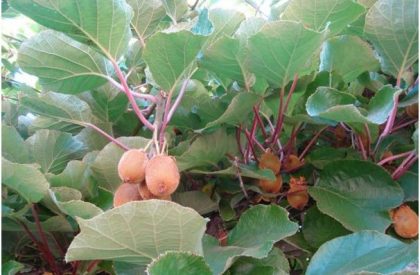How to Grow Kiwi Fruit


How to Grow Kiwi Fruit | Beginners Farming Guide
Kiwis are known as the most expensive temperate climate fruit. But modern farming introduces some varieties which can grow in more cold environments. Radically, Kiwi fruits farming are getting more popular day by day in cold, long non-frost part of the worlds.
Here:
You will agree with me that the primary reason for that. This is so easier to cultivate kiwi plants. Also, it has created a huge demand on global and local markets.
How to Grow Kiwi Fruits Plant?
You can grow Kiwi fruit from both seeds and seedlings. And you can buy them from anywhere. But before doing that I will suggest to you, read the requirements for this Cultivation method. So, without any further ado, let’s begin with the point “how you will start growing Kiwi from veins”.
Here:
The planting process is somewhat similar to grapes. Grapes are also a veins tree. In order to start Kiwi cultivation in your backyard, transplantation of seedling is the easiest process. Though, the germination rate of seeds is about 70%.
But the process is relatively hard to perform. Also, there are several problems that you are likely to face in this step. That is why we recommend you to buy the 2-4 month or older seedling or baby kiwi plant from a plant shop.
Now,
As we already know the plant can grow in less frosty and temperate climate regions in the world but there are also some other environmental requirements.
The Environmental Requirements for Kiwi Fruit Farming:
Kiwi Plants can grow in your backyard garden. But you will have to study the weather, soil PH, and rain or watering system to become successful.
Again, if you can choose a suitable species for your garden, it will be profitable and more productive. We will learn more about selecting the right kind to grow in this guide.
Perfect Weather for growing Kiwi Plants:
You already know that this is a temperate weather plant. It does not tolerate too much hot, cold or rain. It can be grown in Kania, Zimbabwe, India, Italy, Japan, Chile, Australia, Netherland, USA, New Zealand, Turkey, Iran and many other countries.
In case you want to grow this vein plant in the USA in zones 5-9 read through this Kiwi Growing Guide.
The plant thrives under the sunlight any climate that undergoes at below 45-degree F temperatures. But it will require shade on low winter days and early spring sun. On a typical backyard, you can plant the seedling on north facing grades.
Required Soil Nature and PH:
The soil must be well-drained and the Soil PH should be in between 5.5 to 6.5. Kiwifruits thrives in acidic soil.
Watering is another essential part to control, but the temperate regions are well known for the rain. o, it will require moderate watering on dry seasons only.
One problem that farmers face to maintains soil PH caused by lack of watering and rain. On the other hand, The South Asian countries rain heavily on monsoon days. Too much rain is risky for any plants. To avoid infinite problems, you need to plant Kiwi on the high-ground.
How to Grow Better Seedlings:
After selecting the best rhizome. Next, place them aside for several days to enable the split surface region to recover and grow a callus.
Ginger grows gradually, particularly outside. If you are a complete beginner to ginger farming, we will suggest you be patient. However, the sprout might arise within several days if you’re fortunate.
Continue to water for at least a two weeks. Keep hoping…
Do not place the bed under direct sun. A movable tray bed is recommended. In this stage, it needs 3-4 hour of sunlight in the morning and evening. Naturally, one acre of land needs 600 – 800 kg of seed-ginger to sow.
Progressive banana varieties
In local languages, this banana is known as Bhusavali, Basrai, Marisas, Kabuli, Sindurani etc.
It is very popular in India.
Its plant is small, while the fruits are large.
Its pulp appears soft and sweet in food.
This variety is also known as Bambegreen and Harichal.
The areas of the Western Deep Group are famous mainly for its cultivation.
The banana plants can be 3 to 4 meters in height.
While their stem is medium thick and thick green.
Green fruits develop in them.
On an average, each bunch weighs between 25 and 30.
Fruits are yellow.
Customer Feedback
Talented Agronomist
Team Alexa made my Poly-House very well & also helped by assisting in organic Framing. Thanks & All the Best for the future.
Ms. Poonam Saxena, Indore (M.P.)
landownerExcellent job, excellent workmanship
Currently, Team Alexa helping me on Orchid Cultivation in Poly house. I’ve have to say till now everything is good and expecting the same for future.
Mr. Rajendra singh , Indore (M.P.)
landownerGreat ! Work
I would suggest Alexa Farms for Poly house Farming , Hi Tech Farming Organic Farming because there professionals have knowledge for all the crops.
Mahant Dharmendra Puri, Indore
landownerDone Wonderful job
Amazing design and installation of our new, beautiful yard. Gardener is professional, creative and knowledgeable designer.
Mark Angelino
NewyorkPlanting & Removal Charges
Within a your budget you can freshen up your plant with a few key upgrades that will increase your home’s curb appeal. A new gravel driveway or concrete walkway can make your home look like new. Small budgets are good for breaking up a larger project into manageable chunks, so you might splurge for a nice walkway this year and deal with the driveway later.

